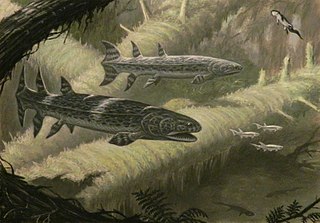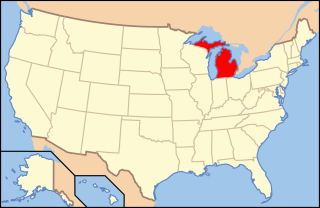The Devonian is a geologic period and system of the Paleozoic, spanning 60 million years from the end of the Silurian, 419.2 million years ago (Mya), to the beginning of the Carboniferous, 358.9 Mya. It is named after Devon, England, where rocks from this period were first studied.
The PaleozoicEra is the earliest of three geologic eras of the Phanerozoic Eon. It is the longest of the Phanerozoic eras, lasting from 541 to 251.902 million years ago, and is subdivided into six geologic periods : the Cambrian, Ordovician, Silurian, Devonian, Carboniferous, and Permian. The Paleozoic comes after the Neoproterozoic Era of the Proterozoic Eon and is followed by the Mesozoic Era.

The Sarcopterygii or lobe-finned fish —sometimes considered synonymous with Crossopterygii —constitute a clade of the bony fish, though a strict cladistic view includes the terrestrial vertebrates.

Anders Erik Vilhelm Jarvik was a Swedish paleontologist who worked extensively on the sarcopterygian fish Eusthenopteron. In a career that spanned some 60 years, Jarvik produced some of the most detailed anatomical work on this fish, making it arguably the best known fossil vertebrate.

Placodermi is a class of armoured prehistoric fish, known from fossils, which lived from the Silurian to the end of the Devonian period. Their head and thorax were covered by articulated armoured plates and the rest of the body was scaled or naked, depending on the species. Placoderms were among the first jawed fish; their jaws likely evolved from the first of their gill arches. Placoderms are paraphyletic, and consist of several distinct outgroups or sister taxa to all living jawed vertebrates, which originated among their ranks. This is illustrated by a 419-million-year-old fossil, Entelognathus, from China, which is the only known placoderm with a type of bony jaw like that found in modern bony fishes. This includes a dentary bone, which is found in humans and other tetrapods. A recent analyses shows placodermi to be likely monophyletic. The jaws in other placoderms were simplified and consisted of a single bone. Placoderms were also the first fish to develop pelvic fins, the precursor to hindlimbs in tetrapods, as well as true teeth. Paraphyletic groupings are problematic, as one can not talk precisely about their phylogenic relationships, their characteristic traits and literal extinction. 380-million-year-old fossils of three other genera, Incisoscutum, Materpiscis and Austroptyctodus, represent the oldest known examples of live birth.

Eusthenopteron is a genus of prehistoric sarcopterygian which has attained an iconic status from its close relationships to tetrapods. The name derives from two Greek stems—eustheno- "strength" and -pteron "wing" and thus "strongly developed fins". Early depictions of this animal show it emerging onto land; however, paleontologists now widely agree that it was a strictly aquatic animal. The genus Eusthenopteron is known from several species that lived during the Late Devonian period, about 385 million years ago. Eusthenopteron was first described by J. F. Whiteaves in 1881, as part of a large collection of fishes from Miguasha, Quebec. Some 2,000 Eusthenopteron specimens have been collected from Miguasha, one of which was the object of intensely detailed study and several papers from the 1940s to the 1990s by paleoichthyologist Erik Jarvik.

Arthrodira is an order of extinct armoured, jawed fishes of the class Placodermi that flourished in the Devonian period before their sudden extinction, surviving for about 50 million years and penetrating most marine ecological niches.

Hyneria is a genus of large prehistoric predatory lobe-finned fish that lived during the Devonian period around 360 million years ago.

Holoptychius is an extinct genus of porolepiform lobe-finned fish from the Middle Devonian to Carboniferous (Mississippian) periods. It is known from fossils worldwide. The genus was first described by Louis Agassiz in 1839.
Kenichthys is a genus of sarcopterygian fish from the Devonian period, and a member of the clade tetrapodomorpha. The only known species of the genus is Kenichthys campbelli, the first remains of which were found in China in 1993. The genus is important to the study of the evolution of tetrapods due to the unique nature of its nostrils, which provide vital evidence regarding the evolutionary transition of fish-like nostrils to the vertebrate choanae.

Gogonasus was a lobe-finned fish known from 3-dimensionally preserved 380 million-year-old fossils found from the Gogo Formation in Western Australia. It lived in the late Devonian period, on what was once a 1400 kilometre coral reef off the Kimberley coast surrounding the north-west of Australia. Gogonasus was a small fish reaching 30–40 cm (1 ft) in length.

Brindabellaspis stensioi is a flat-snouted placoderm with a platypus-like snout from the Early Devonian of the Taemas-Wee Jasper reef in Australia. When it was first discovered in 1980, it was originally regarded as a Weejasperaspid acanthothoracid due to anatomical similarities with the other species found at the reef.
Obruchevichthys is an extinct genus of tetrapod from Latvia during the Late Devonian. When the jawbone, the only known fossil of this creature, was uncovered in Latvia, it was mistaken as a lobe-fin fish. However, when it was analyzed, it proved to hold many similarities to Elginerpeton, from Scotland. It was then declared belonging to the earliest group of tetrapods.
Livoniana is a genus of prehistoric lobe-finned fish which lived during the Devonian period.
The Canowindridae are a family of prehistoric lobe-finned fishes which lived during the Devonian period. Fossils of fishes that belonged to this family have been found in Australia, Antarctica, and Europe.

Elpistostegalia or Panderichthyida is an order of prehistoric lobe-finned fishes which lived during the Late Devonian period. They represent the advanced tetrapodomorph stock, the fishes more closely related to tetrapods than the osteolepiform fishes. The earliest elpistostegalians, combining fishlike and tetrapod-like characters, are sometimes called fishapods, a phrase coined for the advanced elpistostegalian Tiktaalik.

Eotetrapodiformes is a clade of sarcopterygian fish including tetrapods and their immediate ancestors, two groups of stem tetrapods called tristichopterids and elpistostegalids. Eotetrapodiformes is part of the larger clade Tetrapodomorpha, but exclude the basalmost tetrapodomorphs, such as osteolepiforms.

Paleontology in Michigan refers to paleontological research occurring within or conducted by people from the U.S. state of Michigan. During the Precambrian, the Upper Peninsula was home to filamentous algae. The remains it left behind are among the oldest known fossils in the world. During the early part of the Paleozoic Michigan was covered by a shallow tropical sea which was home to a rich invertebrate fauna including brachiopods, corals, crinoids, and trilobites. Primitive armored fishes and sharks were also present. Swamps covered the state during the Carboniferous. There are little to no sedimentary deposits in the state for an interval spanning from the Permian to the end of the Neogene. Deposition resumed as glaciers transformed the state's landscape during the Pleistocene. Michigan was home to large mammals like mammoths and mastodons at that time. The Holocene American mastodon, Mammut americanum, is the Michigan state fossil. The Petoskey stone, which is made of fossil coral, is the state stone of Michigan.

The evolution of fish began about 530 million years ago during the Cambrian explosion. It was during this time that the early chordates developed the skull and the vertebral column, leading to the first craniates and vertebrates. The first fish lineages belong to the Agnatha, or jawless fish. Early examples include Haikouichthys. During the late Cambrian, eel-like jawless fish called the conodonts, and small mostly armoured fish known as ostracoderms, first appeared. Most jawless fish are now extinct; but the extant lampreys may approximate ancient pre-jawed fish. Lampreys belong to the Cyclostomata, which includes the extant hagfish, and this group may have split early on from other agnathans.

Ptyctodus is an extinct armour-plated fish of the late Devonian. Ptyctodus belongs to the family Ptyctodontidae and is of the Placodermi class. They share a close resemblance to modern day chimaeras (Holocephali). Fossils of this armour-plated fish have been found in locations such as in Russia, the Michigan Basis, and Arizona, United States.














